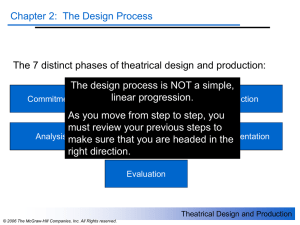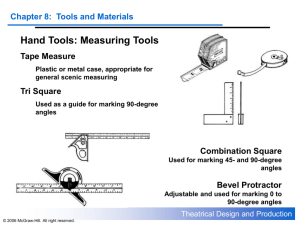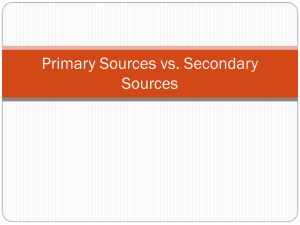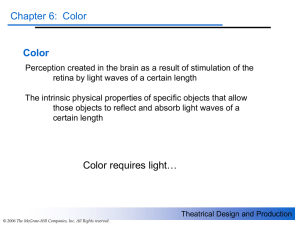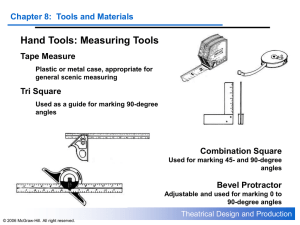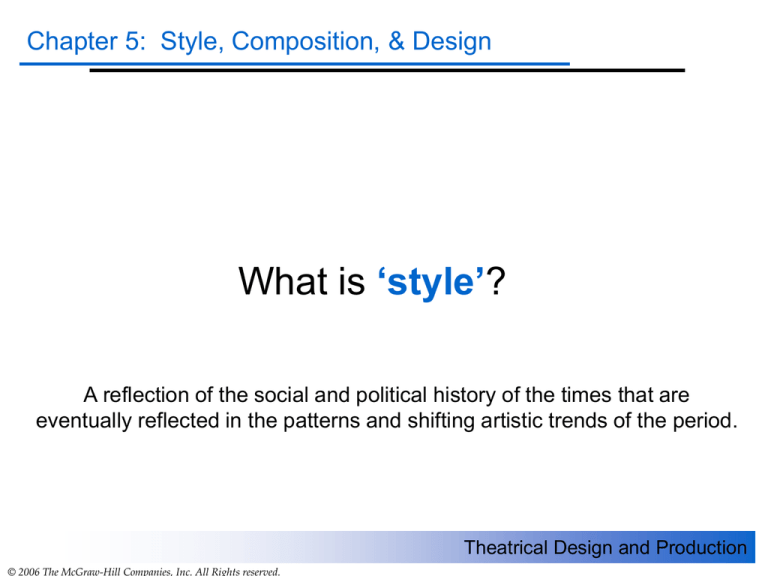
Chapter 5: Style, Composition, & Design
What is ‘style’?
A reflection of the social and political history of the times that are
eventually reflected in the patterns and shifting artistic trends of the period.
Theatrical Design and Production
© 2006 The McGraw-Hill Companies, Inc. All Rights reserved.
Chapter 5: Style, Composition, & Design
Production Style:
A manner of producing a play in which all production elements
(costumes, scenery, lights, acting) adhere to a common set of
artistic/philosophical characteristics (e.g. Expressionism)
What is the
pattern of
elements in this
rendering for
The Kitchen?
Theatrical Design and Production
© 2006 The McGraw-Hill Companies, Inc. All Rights reserved.
Chapter 5: Style, Composition, & Design
The problem with style….
Periods in art/history are only indicative – not definitive
Cannot represent historical periods or styles accurately onstage
Designers are from the modern era and reflect their
background
Audience expectations won’t allow accuracy
The Solution: Stylization!!!
Use of specific compositional elements characteristic of a particular
style or period to create the essence of that style or period.
Theatrical Design and Production
© 2006 The McGraw-Hill Companies, Inc. All Rights reserved.
Chapter 5: Style, Composition, & Design
More issues with style….
Acknowledge the
literary style of
the piece.
Verse vs. prose
Visual style can
reflect the literary
style of the
drama
Theatrical Design and Production
© 2006 The McGraw-Hill Companies, Inc. All Rights reserved.
Chapter 5: Style, Composition, & Design
Elements of Design: Line
Line: A mark that connects two points.
Line can have….
Dimension – length & width
Quality – shape, value, contrast
Character – emotionally evocative characteristics
Theatrical Design and Production
© 2006 The McGraw-Hill Companies, Inc. All Rights reserved.
Chapter 5: Style, Composition, & Design
Elements of Design: Shape
Any line that encloses a space creates a shape.
Shapes define the outlines of details and silhouettes onstage,
giving meaning to what we see!
Theatrical Design and Production
© 2006 The McGraw-Hill Companies, Inc. All Rights reserved.
Chapter 5: Style, Composition, & Design
Elements of Design: Mass
Flat mass with no weight
MASS
Three-dimensional
manifestation
of shape…
Beginnings
of mass due
to shadow
3D relationship
…creates an awareness of
depth and spatial
arrangements
Theatrical Design and Production
© 2006 The McGraw-Hill Companies, Inc. All Rights reserved.
Chapter 5: Style, Composition, & Design
Elements of Design: Measure
The ability to judge the size
of objects and the relative
distance between them
w/out the aid of measuring
devices
Intuitive skill
Theatrical Design and Production
© 2006 The McGraw-Hill Companies, Inc. All Rights reserved.
Chapter 5: Style, Composition, & Design
Elements of Design: Position
What does
position indicate
in relation to this
design?
Relative location of adjacent shapes or masses
Theatrical Design and Production
© 2006 The McGraw-Hill Companies, Inc. All Rights reserved.
Chapter 5: Style, Composition, & Design
Elements of Design: Color
One of the most complex elements – See Chapter 6 for more information
Theatrical Design and Production
© 2006 The McGraw-Hill Companies, Inc. All Rights reserved.
Chapter 5: Style, Composition, & Design
Elements of Design: Texture
The visual tactile surface characteristics or appearance of an object
Theatrical Design and Production
© 2006 The McGraw-Hill Companies, Inc. All Rights reserved.
Chapter 5: Style, Composition, & Design
Elements of Design: Texture
The primary element creating texture is fabric…
…texture can be created with light using gobos
Gobo: A thin metal template inserted into an ellipsoidal reflector spotlight
to project a shadow pattern of light
Theatrical Design and Production
© 2006 The McGraw-Hill Companies, Inc. All Rights reserved.
Chapter 5: Style, Composition, & Design
Principles of Composition: Unity
The creation of a stylistic plan to which all parts of the design subscribe.
Production concept = Conceptual plan
Theatrical Design and Production
© 2006 The McGraw-Hill Companies, Inc. All Rights reserved.
Chapter 5: Style, Composition, & Design
Principles of Composition: Harmony
Sense of blending and
unity that is obtained when
all elements of the design
fit together to create an
orderly whole…
Be aware
that too much harmony
can become monotonous…
Theatrical Design and Production
© 2006 The McGraw-Hill Companies, Inc. All Rights reserved.
Chapter 5: Style, Composition, & Design
Principles of Composition: Contrast
Juxtaposition
of dissimilar
design
elements
Be aware that
too much contrast
can destroy unity…
Theatrical Design and Production
© 2006 The McGraw-Hill Companies, Inc. All Rights reserved.
Chapter 5: Style, Composition, & Design
Principles of Composition: Variation
How is variation created in
these patterns?
Create visual interest
by repeating a
simple pattern but
changing it
occasionally
Theatrical Design and Production
© 2006 The McGraw-Hill Companies, Inc. All Rights reserved.
Chapter 5: Style, Composition, & Design
Principles of Composition: Balance
Symmetrical balance –
correspondence in size, form, and
relative position of parts on either side of
a center dividing line – mirror balance
Arranging design elements
to give a sense of
restfulness, stability, or
equilibrium
Asymmetrical balance – a sense of equality
achieved through dynamic tension created
by the juxtaposition of dissimilar design
elements
Theatrical Design and Production
© 2006 The McGraw-Hill Companies, Inc. All Rights reserved.
Chapter 5: Style, Composition, & Design
Principles of Composition: Proportion
Harmonious relationship of the parts of an object to each other or to the whole
The idea of
beauty
is based on
ideal
proportions
Theatrical Design and Production
© 2006 The McGraw-Hill Companies, Inc. All Rights reserved.
Chapter 5: Style, Composition, & Design
Principles of Composition: Emphasis
Directing the audience’s attention to a specific place…
Where is the
emphasis in this
production image?
How is that
emphasis
created?
…such areas of focus are also known as acting areas
Theatrical Design and Production
© 2006 The McGraw-Hill Companies, Inc. All Rights reserved.
Chapter 5: Style, Composition, & Design
Design Analysis of The Kitchen
Unity
Harmony
Contrast
Variation
Balance
Proportion
Emphasis
Apply the concepts from this lecture to this image.
Theatrical Design and Production
© 2006 The McGraw-Hill Companies, Inc. All Rights reserved.

